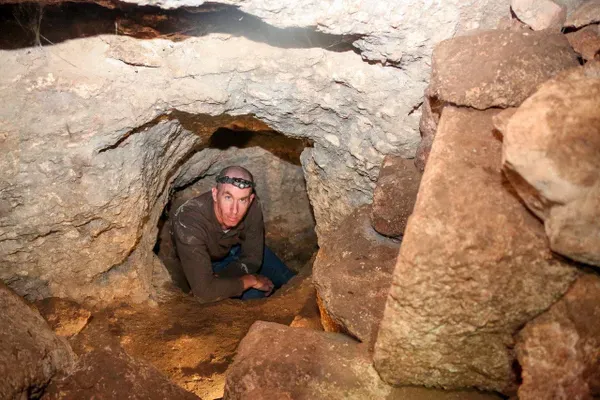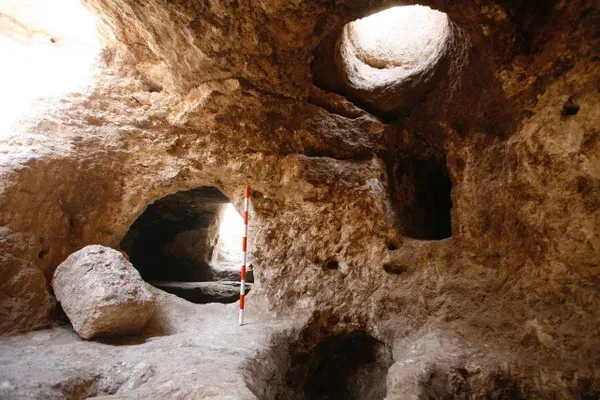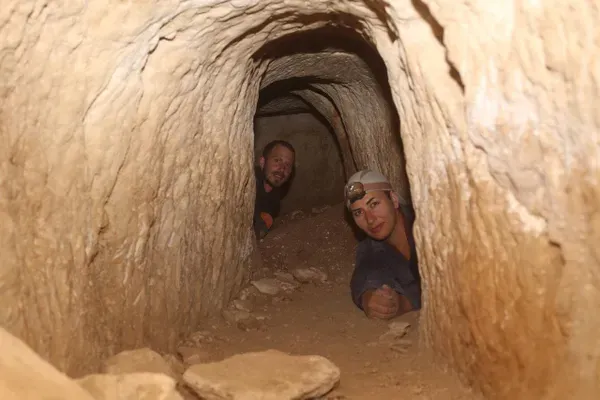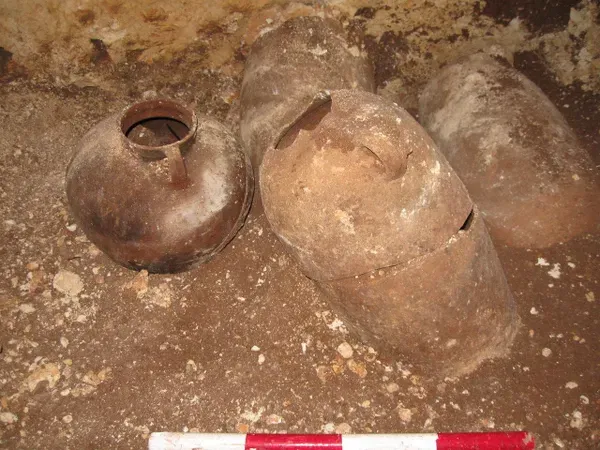New finds show that the rock-cut shelters, once linked to the Bar Kochba Revolt, originated earlier as a Jewish strategy to resist all foreign encroachment
Beneath much of Israel, deep underground, there is a mirror world of ancient winding tunnels, tight burrows and broad chambers hewn into the rock.
Archaeologists have long known that most Jewish settlements in Roman-era Judea were equipped with a labyrinth of elaborate concealed spaces that enabled the inhabitants to hide from attacks, and if necessary, survive underground for a long time.
These hiding complexes were initially linked mostly to the Bar Kochba Revolt, a grueling conflict in the second century C.E. that was the last major attempt by Jews to shake off Roman rule.
But recent discoveries have shown that the phenomenon began much earlier, possibly even before the arrival of the Romans, experts interviewed by Haaretz say. These hiding places have a more complex history than previously thought, and they evolved over time to become a key element in the long-term strategy of Jewish resistance to foreign encroachment.
Nowhere to go
Many people will be more familiar with the use of natural caves, particularly around the Dead Sea, as last-resort shelters in times of strife. That is largely because these remote caverns, thanks to their relative isolation and the dry desert climate, have yielded spectacular ancient finds, from the famed Dead Sea Scrolls to perfectly preserved ancient weapons.
But for most Roman-era Judeans, hope for safety and survival in wartime lay much closer: in the labyrinthine complexes they themselves had carved into the bedrock beneath their own homes.
"It was a must-have," explains Alexander Melamed, an archaeologist who has excavated one of the largest hiding complexes ever found in Israel: in Nesher-Ramla.
"Judea of 2000 years ago is not a quiet place. Leaders change constantly, there are conflicts, both civil wars and foreign invasions," he says. "People have nowhere to go, and they live in a very a hostile environment. Where do they hide? Underground."
Archaeologists have found some 530 hiding complexes at nearly 300 sites, mainly scattered between modern-day central Israel, the West Bank and the Galilee in the north, reports a 2022 study by Dr. Dvir Raviv and Prof. Boaz Zissu, two archaeologists at Bar-Ilan University.
Scholars began investigating these underground spaces in the 1970s, and immediately linked them to the Bar Kochba Revolt. This conflict, named after the leader of the Jewish forces, Simon Bar Kochba, lasted from 132 to 136 C.E. and despite some initial successes for the rebels, it ultimately led to utter defeat and the end of Jewish life in Judea for centuries. The initial interpretation of the underground complexes was that the rebels used them as bases for guerrilla attacks against the Romans, hitting the enemy and quickly withdrawing underground. This was mainly based on the writings of Cassius Dio, a Greco-Roman historian who documented the bloody conflict, writing:
"[The Jews] did not dare try conclusions with the Romans in the open field, but they occupied the advantageous positions in the country and strengthened them with mines and walls, in order that they might have places of refuge whenever they should be hard pressed, and might meet together unobserved under ground; and they pierced these subterranean passages from above at intervals to let in air and light."

While most of the hiding complexes still seem to have been built in preparation for the Bar Kochba Revolt, finds at multiple sites now show they existed already in the late Second Temple period, Raviv tells Haaretz. Some were in use at the time of the First Revolt, which ended with the destruction of the Temple in Jerusalem in 70 C.E., while others go back to Hasmonean times, to the first century B.C.E., he adds.
A hushed discovery
One of the most important recent contributions to the study of this phenomenon comes from the massive salvage excavation of the hiding complex at Nesher-Ramla, near the central Israeli city of Ramla. The site is part of the quarry used by the Nesher cement company, and archaeologists have been digging there for two decades, working ahead of bulldozers to investigate and document a large Jewish Second Temple-period rural town – as well as the Christian Byzantine settlement that was later built on top of it.
The Jewish town's secret underworld included more than fifty complexes, some burrowing on for dozens of meters into the rock, says Melamed, who excavated Nesher-Ramla for 12 years for Haifa University. Some complexes were simple storage units to squirrel away supplies, but many exhibited the hallmarks of hiding places for humans: tight, winding burrows to make access to an enemy harder; "locking" mechanisms (usually a rolling stone) that could only be operated from the inside; tunnels connecting the hiding chambers to local wells or cisterns to ensure a water supply.

Crucially, coins and other finds from the site date from the end of the Hasmonean period, in the first half of the first century B.C.E., to the first century C.E. The almost total lack of finds from the second century C.E. indicates the settlement had already been abandoned by then, possibly as a consequence of the devastation wrought during the First Revolt, Melamed says.
More broadly, only some two dozen coins from the Bar Kochba Revolt have been found in the hundreds of hiding complexes across Israel, Melamed noted in a 2022 study.
This indicates that scholars may have been too quick to link them so closely to this revolt and interpret them as part of a centralized preparation plan ahead of the war, he says.
"No one had a set plan, these hiding places developed organically, people dug under their own homes to create a hiding space, based on the will and needs of the owners," Melamed tells Haaretz by phone.
Some might suggest a seeming similarity between the ancient Jewish hiding places and the modern-day tunnels dug by the Hamas terror group under the Gaza Strip, but Melamed dismisses any parallels as "unscientific". He argues that the hiding places of old were shelters for the local population, while Hamas leaders have themselves made clear that their underground network is there to protect their fighters, not civilians. Rather, Melamed likens the hiding complexes to the modern-day reinforced concrete room that all newly built homes and apartments in Israel must include.
"In days of peace it serves as a storage space and when suddenly war breaks out it's used as a refuge or a way for civilians to escape," he says.
As a side note, a parallel dig of a prehistoric site at the Nesher-Ramla quarry has made international headlines, but archaeologists have been very hush-hush, beyond academic publications, about the Second Temple-period hiding complex they have been investigating there.
That's largely because they feared hordes of visitors eager to explore the tunnels would appear at what is a actually a dangerous construction site, Melamed asserts. He feels free to speak about it now as most of the ancient site has since been bulldozed and churned up into cement. This is a fairly common occurrence in Israel, where balancing modern infrastructure building and heritage preservation is often a difficult exercise. Before construction (or quarrying, in this case), developers must finance a salvage excavation, but authorities still tend to greenlight projects once archaeologists have documented or removed any discoveries.
"On one hand it is sad this ancient site will not survive, on the other, without the budget that Nesher provided we would never have been able to excavate an entire hiding complex as we did and we wouldn't know anything about it," Melamed says. "Usually these systems can only be partially excavated."
Fortunately the subterranean complex at Nesher-Ramle is just one example of a phenomenon that seems to have been ubiquitous across Jewish settlements in Judea, although quite unique in the Roman world, he says. While there were other underground hiding spaces in the Roman Empire, for example in Turkey, the reliance of Judeans on rock-hewn shelters seems to have been particularly heavy.
There were several factors at work, Raviv says. These included the soft chalkstone that makes up large sections of the bedrock in Judea; the population's familiarity with rock-hewing techniques to build other structures (cisterns, rituals baths, oil presses, tombs) and lastly the fact that the Jews were a quite stubborn population that rebelled against the Romans every few generations, giving them a cumulative experience of the advantages of underground warfare. Add to this that there were no thick forested areas to hide in, as in Europe, and that all neighboring regions were pretty much faithful Roman provinces, and the choice to seek shelter underground seems obvious, Melamed notes.
Offensive or defensive?
Despite the new findings at Nesher-Ramle and at other sites, there is still disagreement amongst archaeologists on the dating and function of the hiding complexes, particularly the weight they had in the Bar Kochba Revolt, says Raviv, who recently critiqued the conclusions Melamed drew from his dig at Nesher-Ramla.
There is broad consensus on the idea that the phenomenon started much earlier, in the first century B.C.E., probably as a development of concealed storage spaces where agricultural produce was hidden away to avoid taxation, Raviv agrees. These and other underground spaces were adapted and expanded to house people already in these early days, possibly during the wars between the last Hasmonean rulers and the pro-Roman Herodian dynasty in the mid first century B.C.E.
Their use was then perfected with each bout of fighting, through the First Revolt and up until the Bar Kochba war, Raviv maintains.
The Nesher-Ramla complex is somewhat atypical in that it was no longer in use by the second century C.E. says Eitan Klein, an Israel Antiquities Authority archaeologist and an expert on hiding complexes. However there are plenty more complexes that were used in the Bar Kochba Revolt, says Klein, who has dug one such underground system at Horvat Ethri, a village southwest of Jerusalem that was destroyed in the war.
The typical feature of hiding complexes from this period was that they included connections between previously isolated underground systems, creating a single huge labyrinth that allowed people to move easily from one side of a settlement to another or even leave the town entirely, Klein says.
"In this they are very similar to the Hamas tunnels we see in Gaza, or rather, they copied it from us," he says.

There is still a debate over how much of a military and offensive role the hiding complexes played in Bar Kochba's time. On one hand, their initial interpretation in the 1970s and 1980s as guerrilla bases seems to have been overplayed, Klein says. This is largely because most entrance and exist shafts for these complexes are very tight, forcing anyone to crawl through. This is not compatible with the idea of large forces being able to quickly leave and re-enter a tunnel for hit-and-run attacks, he notes.
There are only a few hiding complexes, generally connected to fortified settlements, that have wider access tunnels and were likely used for a more offensive function, Raviv adds. The main example is at Herodion, the fortress and monumental tomb of Herod the Great, located south of Jerusalem, which served as a major stronghold for Bar Kochba. There the rebels dug an intricate system of tunnels that permitted rapid and unobserved movement by fighters from the fortress to the area where the Romans positioned their siege machines, suggesting that these were offensive tunnels used to sally against the enemy, rather than to escape the site, he says.
A deadly hide-and-seek
By and large however, these were exceptions. The underground complexes served mostly as places of shelter – and they are termed "machboah" (hiding place) also by the Mishnah, the second century C.E. compendium of Jewish oral law, Klein says.
That doesn't mean that they didn't serve a military purpose by hiding fighters as well as civilians, particularly during the Bar Kochba Revolt, he adds. Just by providing refuge to rebels, the complexes kept them alive to fight another day and continue their guerrilla war. In this function there is a certain parallel between the ancient Judean tunnels and the modern Hamas versions, though the latter were dug for offensive purposes, Raviv adds.
It took the Romans four years of bloody fighting to put down the revolt, with the help of some 12 legions, a considerable proportion of the entire empire's military might at the time. Emperor Hadrian had to send in soldiers and commanders from distant provinces, including Germany and Britain. The huge amount of manpower, more than 100,000 men, was needed to hunt down the rebel bands village by village, tunnel by tunnel, Klein says.
Since the tight burrows virtually nullified the power and training of the legions and made it hard for the heavily armored soldiers to maneuver, Roman troops rarely entered the hiding complexes, preferring instead to smoke out any resistance, Klein says. This method is attested both by the Jewish historian Josephus for the First Revolt and rabbinic sources from after the Bar Kochba Revolt.
The difficulties encountered by Hadrian's troops mirror those that Israeli soldiers face in hunting down Hamas terrorists in the tunnels they dug under Gaza, Raviv and Klein note.
